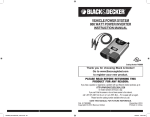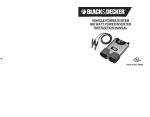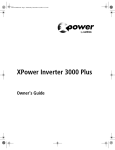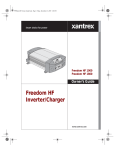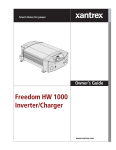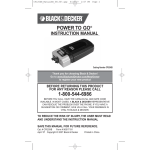Download Black & Decker 200 WATT Instruction manual
Transcript
VEHICLE POWER SYSTEM 500 WATT POWER INVERTER WITH USB CHARGING PORT INSTRUCTION MANUAL Catalog Number PI500BB • Do not make any electrical connections or disconnections in areas designated as IGNITION PROTECTED. This includes DC cigarette lighter type plug connection or airplane adapter. This unit is NOT approved for ignition protected areas. • NEVER immerse the unit in water or any other liquid, or use when wet. • Do not insert foreign objects into the AC outlet or the USB outlet. WARNING: TO REDUCE THE RISK OF FIRE: • Do not operate near flammable materials, fumes or gases. • DO NOT expose to extreme heat or flames. CAUTION: TO REDUCE THE RISK OF INJURY OR PROPERTY DAMAGE: • Remove appliance plug from outlet before working on the appliance. • DO NOT attempt to connect or set up the unit or its components while operating your vehicle. Not paying attention to the road may result in a serious accident. • Always use the inverter where there is adequate ventilation. Do not block ventilation slots. • ALWAYS turn the inverter OFF by disconnecting it from the DC source when not in use. • Make sure the nominal powering voltage is 12 volts DC, center connection positive (+). • When using this unit in a vehicle, check the vehicle owner’s manual for maximum power rating and recommended output. Do not install in engine compartment — install in a well ventilated area. • Do not use with positive ground electrical systems.* Reverse polarity connection will result in a blown fuse and may cause permanent damage to the inverter and will void warranty. *The majority of modern automobiles, RVs and trucks are negative ground. • Keep in mind that this inverter will not operate high wattage appliances or equipment that produce heat, such as hair dryers, microwave ovens and toasters. • Do not open the inverter — there are no user-serviceable parts inside. • Do not use this inverter with medical devices. It is not tested for medical applications. • Keep away from children.This is not a toy! • Install and operate unit only as described in this Instruction Manual. • Do not use this inverter on a watercraft. It is not qualified for marine applications. • Check unit periodically for wear and tear. Take to a qualified technician for replacement of worn or defective parts immediately. • Read And Understand This Instruction Manual Before Using This Unit. SAVE THESE INSTRUCTIONS WARNING: TO REDUCE THE RISK OF INJURY: SAFETY GUIDELINES / DEFINITIONS DANGER: Indicates an imminently hazardous situation which, if not avoided, will result in death or serious injury. WARNING: Indicates a potentially hazardous situation which, if not avoided, could result in death or serious injury. CAUTION: Indicates a potentially hazardous situation which, if not avoided, may result in minor or moderate injury. CAUTION: Used without the safety alert symbol indicates potentially hazardous situation which, if not avoided, may result in property damage. RISK OF UNSAFE OPERATION. When using tools or equipment, basic safety precautions should always be followed to reduce the risk of personal injury. Improper operation, maintenance or modification of tools or equipment could result in serious injury and property damage. There are certain applications for which tools and equipment are designed. Black & Decker strongly recommends that this product NOT be modified and/or used for any application other than for which it was designed. Read and understand all warnings and operating instructions before using any tool or equipment. IMPORTANT SAFETY INSTRUCTIONS GENERAL SAFETY WARNINGS AND INSTRUCTIONS FOR ALL APPLIANCES READ ALL INSTRUCTIONS WARNING: Read all instructions before operating product. Failure to follow all instructions listed below may result in electric shock, fire and/or serious injury. • AVOID DANGEROUS ENVIRONMENTS. Don’t use appliances in damp or wet locations. Don’t use appliances in the rain. • STORE IDLE APPLIANCES INDOORS. When not in use, appliances should be stored indoors in dry, and high or locked-up place – out of reach of children. • DON’T FORCE APPLIANCE. It will do the job better and with less likelihood of a risk of injury at the rate for which it was designed. • USE RIGHT APPLIANCE. Do not use the appliance for any job except that for which it is intended. • DISCONNECT APPLIANCES. Disconnect the appliance from the power supply when not in use, before servicing, and when changing accessories such as blades and the like. • PROPER COOLING IS ESSENTIAL WHEN OPERATING THE INVERTER. Do not place the unit near the vehicle’s heat vent or in direct sunlight. • USE OF ACCESSORIES AND ATTACHMENTS. The use of any accessory or attachment not recommended for use with this appliance could be hazardous. Note: Refer to the accessory section of this manual for further details. • CHECK DAMAGED PARTS. A part that is damaged should be properly repaired or replaced by an authorized service center. • OUTDOOR USE EXTENSION CORDS. When an appliance plugged into this unit is used outdoors, use only extension cords intended for use outdoors and so marked. Note that this INVERTER is NOT INTENDED TO BE USED OUTDOORS. • EXTENSION CORDS. Make sure your extension cord is in good condition. When using an extension cord, be sure to use one heavy enough to carry the current your product will draw. An undersized cord will cause a drop in line voltage resulting in loss of power and overheating. The following table shows the correct size to use depending on cord length and nameplate ampere rating. If in doubt, use the next heavier gauge. The smaller the gauge number, the heavier the cord. Volts 120V 240V Ampere Rating More Not more Than Than 0 6 6 10 10 12 12 16 Minimum Gauge for Cord Sets 0-25 (0-7.6m) 0-50 (0-15.2m) Total Length of Cord in Feet 26-50 51-100 (7.6-15.2m) (15.2-30.4m) 51-100 (15.2-30.4m) 101-200 (30.4-60.9m) 101-150 (30.4-45.7m) 201-300 (60.9-91.4m) American Wire Gauge 18 18 16 14 16 16 16 12 16 14 14 12 14 12 Not Recommended WARNING: This product or its power cord contains lead, a chemical known to the State of California to cause cancer and birth defect or other reproductive harm. Wash hands after handling. WARNING: TO REDUCE THE RISK OF ELECTRIC SHOCK: • Do not connect to AC distribution wiring. Follow these instructions and those published by battery manfacturer and the manufacturer of any equipment you intend to use with this unit. Review cautionary markings on these products and on engine. INTRODUCTION Thank you for purchasing the PI500BB 500 watt Power Inverter with USB Charging Port. This inverter can be used to operate personal electronics such as: laptop computers, digital/video cameras, MP3 players, cell phones, PDAs, and more. It can also be used to recharge 110/120 volt AC devices that have an appropriate recharging adapter with a standard North American two- or three-prong plug. Please read this Instruction Manual carefully before use to ensure optimum performance and to avoid damage to this product. FEATURES The unit has 2 LED indicators, 1 to show input conditions and 1 to show output conditions. The input LED is located beside the power button and the output LED is located on the top of the unit between the 2 AC outlets. A green LED indicates normal operation, a red LED indicates a fault condition (refer to Troubleshooting Section of this manual.) and an amber LED indicates low input voltage from the DC source. The AC and USB outlets are ready to use if you have a green output LED. The Power Pushbutton turns the inverter ON and OFF. It can also be used to force reset of inverter circuits by pressing it OFF (no LEDs are lit), then back ON again. AC power is supplied through two standard North American three-prong type outlets. The outlets can accommodate either two- or three-pin AC plugs. Controls and Functions DC ACCESSORY OUTLET PLUG ON/OFF INPUT POWER BUTTON LED INDICATOR BACK OF UNIT HIGH-SPEED COOLING FAN (BLACK) NEGATIVE CABLE POST (RED) POSITIVE CABLE POST BATTERY CLIPS (WITH CABLES) 115 VOLT AC OUTLETS OUTPUT LED INDICATOR USB OUTLET DC ACCESSORY OUTLET HOW THIS INVERTER WORKS This inverter is an electronic device that converts low voltage DC (direct current) electricity from a battery to 115 volt AC (alternating current) household power. In designing this inverter, Black & Decker has incorporated design techniques previously employed in computer power supplies. The result of these design innovations is a smaller, lighter and easier-to-use power inverter. Power Inverter Output Waveform NOTICE: THE OUTPUT OF THIS DEVICE IS NOT SINUSOIDAL. IT HAS A TOTAL HARMONIC DISTORTION OF 36 PERCENT AND MAXIMUM SINGLE HARMONIC OF 28 PERCENT AT 100% RATED LOAD. IMPORTANT: This inverter output is not pure-sinusoidal. Therefore this is not suitable for use to power the following devices: . Microwave Ovens; . Transformerless Battery Chargers Doing so, may cause the device to run warmer or overheat. The AC output waveform of this inverter is known as a modified sine wave. It is a stepped waveform that has characteristics similar to the sine wave shape of utility power. This type of waveform is suitable for most AC loads, including linear and switching power supplies used in electronic equipment, transformers, and small motors. The modified sine wave produced by this inverter has an RMS (root mean square) voltage of 115 volts. Most AC voltmeters (both digital and analog) are sensitive to the average value of the waveform rather than the RMS value. They are calibrated for RMS voltage under the assumption that the waveform measured will be a pure sine wave. These meters will not correctly read the RMS voltage of a modified sine wave. Non-TRUE RMS meters will read about 20 to 30 volts low when measuring the output of this inverter. For accurate measurement of the output voltage of this unit, use a TRUE RMS reading voltmeter such as a Fluke 87, Fluke 8080A, Beckman 4410 or Triplett 4200. 115 Volt AC Output CAUTION – Rechargeable Devices • Certain rechargeable devices are designed to be charged by plugging them directly into an AC receptacle. These devices may damage the inverter or the charging circuit. • When using a rechargeable device, monitor its temperature for the initial ten minutes of use to determine if it produces excessive heat. • If excessive heat is produced, this indicates the device should not be used with this inverter. • This problem does not occur with most battery-operated equipment. Most of these devices use a separate charger or transformer that is plugged into an AC receptacle. • The inverter is capable of running most chargers and transformers. OPERATING INSTRUCTIONS The Power Inverter must be connected only to batteries with a nominal output voltage of 12 volts. The unit will not operate from a 6 volt battery and will sustain permanent damage if connected to a 24 volt battery. Always connect the PI500BB to the 12 volt DC power source before plugging any devices into the unit. The standard North American 115 volt AC and USB outlets allow simultaneous operation of multiple devices. Simply plug the equipment into the unit and operate normally. Ensure that the wattage of all equipment simultaneously plugged into the PI500BB does not exceed 500 watts continuous. Connection to Power Source The Power Inverter comes equipped with a DC Accessory Outlet Plug and Battery Clips for connection to a power source. Connecting to a Power Source Using the DC Accessory Outlet Plug (Up to 90W only) The DC Accessory Outlet Plug is suitable for operating the inverter at power outputs up to 90 watts and has overload protection at 90W to prevent you blowing the fuse if you connect a higher rated appliance. The tip of the plug is positive (+) and the side contact is negative (–). The opposite end of the DC Accessory Outlet Plug has a unique connector fitted to it which will allow it to be only fitted into the socket on the rear of the unit when there are NO battery clips connected to the unit. This is a safety feature and the design of the plug also covers the positive (+) terminal to prevent both leads being connected at the same time. Connect the inverter to the power source by inserting the DC Accessory Outlet Plug firmly into the accessory outlet of a vehicle or other DC power source. CAUTIONS • Connect directly to power source using the included Battery Clips when operating above 90 watts. • Do not use with positive ground electrical systems. • Reverse polarity connection will result in a blown fuse and may cause permanent damage to the inverter. Notes:Most vehicle accessory outlet circuits have fuses rated at 15 to 20 amps or greater. To operate at full wattage, either use the battery clip cable (supplied) or directly wire to the power source with user-supplied wire and fuse. The majority of modern automobiles, RVs and trucks are negative ground. Once properly connected to a 12 volt DC power source and switched on, the green Power LED Indicator lights indicating that the Inverter is functioning properly and the 90W logo will light up to show you can only power devices up to 90W from this connection. If either the yellow low input voltage LED Indicator or red Fault LED Indicator lights, indicating a fault condition exists, refer to the “Troubleshooting” section of this Instruction Manual. Connecting to a Power Source Using the Provided Battery Clips Use the provided Battery Clips (with cables) to connect the Power Inverter directly to the 12 volt power source as follows: 1.Check to make sure the inverter’s Power Pushbutton has been pressed OFF (no LEDs are lit) and that no flammable fumes are present in the installation area. 2.Connect the red cable to the red post on the back of the inverter . Connect the red Battery Clip to the positive terminal of the battery. 3.Connect the black cable to the black post on the back of the inverter. Connect the black Battery Clip to the negative terminal of the battery. 4.Make sure that all connections between cables and terminals are secure. 5. Once properly connected to a 12 volt power source and switched on, the green power LED indicator lights indicating that the inverter is functioning properly and both the 100W and 500W logos will light up to show what devices you can power. Direct Hardwiring to Power Source (optional connection method; hardware not included) WARNING: It is not recommended to install with cables longer than 10ft as this can adversely effect the operation of your inverter. As this unit can be directly hard wired it has wall mount features built in to secure it in the desired location. The diagram below shows you how to do this. Operation of the USB Charging Port 1.Connect the inverter to a functioning 12 volt DC power source as described in this Instruction Manual. If using the 12 Volt DC Vehicle Accessory Adapter, rotate the vehicle accessory plug slightly to make sure there is good contact. Make sure there is adequate space for proper ventilation of the inverter. 2.Press the Power Pushbutton to turn the unit ON. 3.The green Power LED Indicator will light, indicating a proper connection. If either the yellow Input Fault LED Indicator or red Output Fault LED Indicator lights, indicating a fault condition exists, refer to the “Troubleshooting” section of this Instruction Manual. 4.If the Inverter does not work, make sure the ignition/accessory switch is actually powering the accessory outlet. Some vehicles require the ignition switch to be turned on. 5.Plug the USB-powered device into the inverter’s USB Charging Port and operate normally. Notes:This unit’s USB Charging Port does not support data communication. It only provides 5 volts/500mA DC power to an external USB-powered device. Remember to disconnect the inverter from any power source when not in use. Not all mobile phones are provided with a charging cable, they are normally data cables which are not supported by this device - please check with your mobile phone manufacturer for the correct charging cable. Protective Features The inverter monitors the following conditions: Low Battery Voltage — This condition is not harmful to the inverter, but could damage the power source, so the inverter will automatically shut down when input voltage drops below 10.5 ± 0.3 volts DC. Input Voltage Too High — The inverter will automatically shut down when DC input voltage exceeds 15.5 ± 0.5 volts, as this can harm the unit. Thermal Shutdown Protection — The inverter will automatically shut down when the unit becomes overheated. Overload/Short Circuit Protection — The inverter will automatically shut down when a short circuit occurs. Operating Tips The inverter should only be operated in locations that are: DRY — Do not allow water or other liquids to come into contact with the inverter. COOL — Surrounding air temperature should ideally be 10-20°C (50-68°F). Keep the inverter away from direct sunlight, when possible. WELL-VENTILATED — Keep the area surrounding the inverter clear to ensure free air circulation around the unit. Do not place items on or over the inverter during operation. The unit will shut down if the internal temperature gets too hot. The inverter will auto-reset after it cools down. SAFE — Do not use the inverter near flammable materials or in any locations that may accumulate flammable fumes or gases. This is an electrical appliance that can briefly spark when electrical connections are made or broken. Care and Maintenance Storage 1.Ideal storage temperature range is 0-40°C (32-104°F). 2.Store and use the PI500BB in a cool, dry place with adequate ventilation for all-around air circulation. 3.Avoid locations that are exposed to heating units, radiators, direct sunlight, or excessive humidity or dampness. Fuse Replacement This inverter is equipped with multiple internal fuses. Normally, these fuses will not “blow” unless there is a serious problem inside the unit. Internal fuses are replaceable; however, only trained personnel should attempt fuse replacement. If the unit is damaged during fuse replacement, the warranty may be voided. The fuse in the DC Accessory Outlet Plug is user-replaceable. Make sure to first disconnect the Outlet Plug from any 12 volt DC power source; then replace the fuse with one of the same rating and type. Troubleshooting Use #6 AWG wire if the inverter to power source connection is 6 feet or less. For cable lengths up to 10ft use #4 AWG wire. In either case, protect the positive (+) wire from shorts by installing a 60 ANL fuse or circuit breaker close to the DC power source (battery) terminal. 1.Check to make sure the inverter’s Power Pushbutton has been pressed OFF (no LEDs are lit) and that no flammable fumes are present in the installation area. 2.Identify the positive (+) and negative (–) DC power source (battery) terminals. 3.Install a fuse holder or breaker close to the positive (+) terminal of the DC source (battery). 4.Connect a length of wire on one side of the fuse holder or circuit breaker. Connect the other end of the wire to the positive (+) terminal of the inverter. 5.Connect a length of wire between the inverter’s negative (–) terminal and the DC power source negative (–) terminal. 6.Connect a short length of wire to the other terminal of the fuse holder or circuit breaker. Mark it “positive” or “+”. 7.Connect the free end of the fuse or breaker wire to the positive (+) terminal of the DC power source (battery). 8.Insert a fuse appropriate to the inverter in the fuse holder. 9.Test the inverter by turning it on and plugging in a 100 watt lamp or equipment. 10.If the inverter is not properly operating, then refer to the Troubleshooting section of this manual. CAUTION •The cable and fuse sizes given here are a general recommendation. You should always consult your National Electrical Code prior to beginning each specific installation. • Loose connectors may cause overheated wires and melted insulation. • Check to make sure you have not reversed the polarity. Damage due to reversed polarity is not covered by our warranty. Connection To Load The Power Inverter is equipped with dual standard North American three-prong type outlets. Plug the cord from the equipment you wish to operate into the AC receptacle(s). Make sure the combined load requirement of your equipment does not exceed maximum continuous power. The Power Inverter is engineered to be connected directly to standard electrical and electronic equipment in the manner described above. Do not connect the Power Inverter to household or RV AC distribution wiring. Do not connect the Power Inverter to any AC load circuit in which the neutral conductor is connected to ground (earth) or to the negative of the DC (battery) source. WARNING: Do not connect to AC distribution wiring! Rated Versus Actual Current Draw of Equipment Most electrical tools, appliances, electronic devices and audio/visual equipment have labels that indicate the power consumption in amps or watts. Be sure that the power consumption of the item to be operated is below 500 watts. If the power consumption is rated in amps AC, simply multiply by the AC volts (115) to determine the wattage. Resistive loads are the easiest for the inverter to run; however, it will not run larger resistive loads (such as electric stoves and heaters), which require far more wattage than the inverter can deliver. Inductive loads (such as TVs and stereos) require more current to operate than do resistive loads of the same wattage rating. Inductive loads, i.e. power tools Note: Some motors used in power tools, refrigerators and pumps require a very high surge current to start. This inverter can handle a surge twice it’s rated power but some motors require more than this when started. The inverter will not be harmed if you try to start such a product it will simply shutdown on overload. For safety reasons, the unit will simply shut down if it is overloaded. To restart the unit, simply unplug all devices plugged into the unit; disconnect the unit from any 12 volt DC power source; then reconnect the unit before plugging the appliance back in. Operation of the 115 Volt AC Outlets 1.Connect the inverter to a functioning 12 volt DC power source as described in this Instruction Manual. If using the 12 Volt DC Vehicle Accessory Adapter, rotate the vehicle accessory plug slightly to make sure there is good contact. Make sure there is adequate space for proper ventilation of the inverter. 2.Press the Power Pushbutton to turn the unit ON. 3.The green Power LED Indicator will light, indicating a proper connection. If either the yellow low input voltage LED Indicator or red Fault LED Indicator lights, indicating a fault condition exists, refer to the “Troubleshooting” section of this Instruction Manual. 4.If the Inverter does not work, make sure the ignition/accessory switch is actually powering the accessory outlet. Some vehicles require the ignition switch to be turned on. 5.Plug the (110/120 volt AC) appliance into one of the Inverter’s three-prong AC outlet and operate normally. Note: The Inverter will not operate appliances and equipment that generate heat, such as hair dryers, electric blankets, microwave ovens and toasters. Remember to disconnect the inverter from any power source when not in use. Common Audio/Visual Problems Problem Explanation/Recommendation Buzzing sound in audio systems Some inexpensive stereo systems and boom boxes make a buzzing sound when operated from the inverter, because the power supply in the electronic device does not properly filter the modified sine wave produced by the inverter. The only solution to this problem is to use a sound system that has a higher quality power supply. Problem: Television Interference The inverter is shielded to minimize interference with TV signals. However, in some instances, some interference may still be visible, especially when the TV signal is weak. Try the following to improve the picture: 1.Move the Inverter as far away as possible from the TV set, the antenna, and the antenna cables. Use a short AC extension cord, if necessary. 2.Adjust the orientation of the antenna cables, and the TV power cord to minimize interference. 3.Make sure that the antenna feeding the TV provides an adequate (snowfree) signal and that high quality, shielded antenna cable is used. Fault Conditions Input LED Color Output Possible Cause LED Color Recommendation Yellow Low input voltage Red Battery voltage below Recharge battery or check DC power supply. 10.5 volts Equipment being oper- • Reduce load to maximum 500 watts if connected via ated draws too much battery clips. power • Reduce load to maximum 90 watts if connected via the 12V dc accessory plug. • Connect directly to power source using the included Battery Clips when operating above 100 watts. Red Start Engine Red Inverter in thermal shutdown condition Allow inverter to cool down. Ensure there is adequate ventilation around the load is no more than 500 watts for continuous operation. Red AC output is shorted Unplug the AC appliance. Disconnect the unit from any 12 volt DC power source. Check the appliance cord. Refer to the Service Information section that follows to contact a Black & Decker Service Center. Red or Yellow Fault LED Indicator Lights The red Fault LED indicates inverter shutdown from input fault, over temperature fault or overload / short circuit fault and the yellow Fault LED indicates an input fault. Full Two-Year Home Use Warranty Black & Decker (U.S.) Inc. warrants this product for two years against any defects in material or workmanship. The defective product will be replaced or repaired at no charge in either of two ways. The first, which will result in exchanges only, is to return the product to the retailer from whom it was purchased (provided that the store is a participating retailer). Returns should be made within the time period of the retailer’s policy for exchanges (usually 30 to 90 days after the sale). Proof of purchase may be required. Please check with the retailer for their specific return policy regarding returns that are beyond the time set for exchanges. The second option is to take or send the product (prepaid) to a Black & Decker owned or authorized Service Center for repair or replacement at our option. Proof of purchase may be required.Black & Decker owned and authorized Service Centers are listed under “Tools-Electric” in the yellow pages of the phone directory. This warranty does not apply to accessories. This warranty gives you specific legal rights and you may have other rights which vary from state to state or province to province. Should you have any questions, contact the manager of your nearest Black & Decker Service Center. This product is not intended for commercial use. LATIN AMERICA: This warranty does not apply to products sold in Latin America. For products sold in Latin America, check country specific warranty information contained in the packaging, call the local company or see the website for warranty information. SPECIFICATIONS Maximum Continuous Power: Surge Capacity: USB Output: Input Voltage: Output Voltage: Low Voltage Alarm: Low Voltage Shutdown: Thermal Shutdown: Wave Form: Output Connection: Fuses: Input Cables: Operating Temperature: Storage Temperature: Operating/Relative Humidity: BLACK DECKER ACCESSORIES 500 watts 1000 watts 5 V DC (500mA) 12.8 volts Approx. 115 volt AC RMS 60 Hz <_ 11.0 volts DC 10.5 ± 0.3 volts DC Automatic Modified Sine Wave (MSW) North American Standard Receptacles Internal / DC Accessory Plug: 8 Amps Battery clip cables / 12V DC adapter cable 10-20°C (50-68°F) 0-40°C (32-104°F) 5-95% non-condensing GARAGE ACCESSORIES




